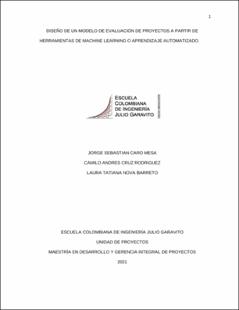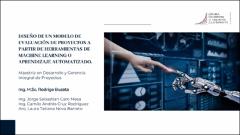Mostrar el registro sencillo del ítem
Diseño de un modelo de evaluación de proyectos a partir de herramientas de machine learning o aprendizaje automatizado..
| dc.contributor.advisor | Buzeta Araya, Rodrigo Javier | |
| dc.contributor.author | Nova Barreto, Laura Tatiana | |
| dc.contributor.author | Caro Mesa, Jorge Sebastián | |
| dc.contributor.author | Cruz Rodriguez, Camilo Andrés | |
| dc.date.accessioned | 2021-05-20T00:28:29Z | |
| dc.date.accessioned | 2021-10-01T17:10:59Z | |
| dc.date.available | 2021-05-20T00:28:29Z | |
| dc.date.available | 2021-10-01T17:10:59Z | |
| dc.date.issued | 2021 | |
| dc.identifier.uri | https://repositorio.escuelaing.edu.co/handle/001/1444 | |
| dc.description.abstract | Organizaciones como The Standish Group publican anualmente estadísticas del porcentaje de éxito o fracaso de proyectos de TI (Tecnología Informática), las cuales revelan que alrededor del 31.1% de los proyectos que se realizan en el transcurso de un año fracasan o son cancelados, el 52.7% superan en costo, tiempo y/o funcionalidad prometida y solo el 16.2% de los mismos se consideran exitosos. Ahora bien, estas cifras corresponden al sector de las Tecnologías de la Información y la Comunicación (TIC), el cual para el año 2017 representaba el 6.5% del PIB mundial; en este sentido, si estas cifras se proyectaran de forma equivalente en el sector de la construcción, cuyo aporte al PIB mundial en el mismo año superaba el 13%, se confirmaría la existencia de una situación alarmante en la ejecución de los proyectos. Cabe señalar que las cifras anteriores, coinciden con las estadísticas entregadas por el Project Management Institute en su informe anual, puesto que para el 2019 los proyectos que fracasaron en su totalidad superaban el 18% y los que no cumplieron con sus objetivos el 39%. No obstante, aquellas empresas que han venido implementado nuevas prácticas, conocidas como “PMTQ Innovators”, han logrado disminuir en un 42% los proyectos que han excedido su presupuesto inicial y en un 46% aquellos que excedieron el tiempo planeado. Por lo anterior, son las alarmantes cifras las que ratifican la necesidad de nuevas herramientas que contribuyan a la disminución de las tasas de fracaso de los proyectos; es aquí donde toma fuerza la incursión del ámbito tecnológico en la evaluación de proyectos y donde esta investigación demuestra que es posible predecir el éxito de los proyectos haciendo uso de herramientas y algoritmos del Machine Learning, a través de un sistema de aprendizaje supervisado, modelado por medio de una red neuronal artificial entrenada a partir de bases de datos históricos de proyectos ejecutados, a los cuales se les calcula su éxito bajo los lineamientos de la triple restricción: costo, tiempo y alcance. Es así, que se da a conocer una herramienta que proporciona a la evaluación de proyectos un indicador diferente a las métricas financieras tradicionales (TIR, VPN, Rentabilidad del Negocio, ROI y B/C (Costo - beneficio)) para la toma de decisiones, con el fin de minimizar la tasa de proyectos fracasados. Finalmente, al entrenar esta herramienta con la data histórica de la última década de los proyectos de infraestructura en Colombia, se determina que si el Estado hubiese usado este modelo, más de 45.000 proyectos no exitosos con costos superiores a 60.000 millones de pesos, pudieron haber sido reestructurados o rechazados previo a su inicio; adicionalmente, se hubieran podido destinar a otros proyectos, recursos superiores a los 5.000 millones de pesos, que fueron ejecutados en más de 1000 contratos fracasados por año. | spa |
| dc.description.abstract | Organizations such as The Standish Group annually publish statistics on the percentage of success or failure of IT (Information Technology) projects, which reveal that about 31.1% of the projects that are carried out in the course of a year fail or are canceled, 52.7% exceed in cost, time and/or promised functionality and only 16.2% of them are considered successful. Now, these figures correspond to the Information and Communication Technologies (ICT) sector, which for the year 2017 represented 6.5% of the world GDP; in this sense, if these figures were projected equivalently in the construction sector, whose contribution to the world GDP in the same year exceeded 13%, the existence of an alarming situation in the execution of projects would be confirmed. It should be noted that the above figures coincide with the statistics provided by the Project Management Institute in its annual report, since by 2019, projects that failed in their entirety exceeded 18% and those that did not meet their objectives exceeded 39%. However, those companies that have been implementing new practices, known as "PMTQ Innovators", have managed to reduce by 42% the projects that exceeded their initial budget and by 46% those that exceeded the planned time. Therefore, these alarming figures ratify the need for new tools that contribute to the reduction of project failure rates; it is here where the incursion of technology in the field of project evaluation takes force and where this research shows that it is possible to predict the success of projects using Machine Learning tools and algorithms, through a supervised learning system, modeled by means of an artificial neural network trained from historical databases of executed projects, whose success is calculated under the guidelines of the triple constraint: cost, time and scope. Thus, a tool is presented that provides project evaluation with an indicator different from the traditional financial metrics (IRR, NPV, Business Profitability, ROI and B/C (Cost - Benefit)) for decision making, in order to minimize the rate of failed projects. Finally, by training this tool with the historical data of the last decade of infrastructure projects in Colombia, it is determined that if the State had used this model, more than 45,000 unsuccessful projects with costs higher than 60,000 million pesos could have been restructured or rejected prior to their start; additionally, resources higher than 5,000 million pesos could have been allocated to other projects, which were executed in more than 1,000 unsuccessful contracts per year. | spa |
| dc.format.extent | 82 páginas | spa |
| dc.format.mimetype | application/pdf | spa |
| dc.language.iso | spa | spa |
| dc.title | Diseño de un modelo de evaluación de proyectos a partir de herramientas de machine learning o aprendizaje automatizado.. | spa |
| dc.type | Trabajo de grado - Maestría | spa |
| dc.type.version | info:eu-repo/semantics/publishedVersion | spa |
| oaire.accessrights | http://purl.org/coar/access_right/c_abf2 | spa |
| oaire.version | http://purl.org/coar/version/c_970fb48d4fbd8a85 | spa |
| dc.contributor.subjectmatterexpert | Blanco Vargas, Camilo | |
| dc.description.degreelevel | Maestría | spa |
| dc.description.degreename | Magíster en Desarrollo y Gerencia Integral de Proyectos | spa |
| dc.identifier.url | https://catalogo.escuelaing.edu.co/cgi-bin/koha/opac-detail.pl?biblionumber=22614 | |
| dc.publisher.place | Bogotá | spa |
| dc.publisher.program | Maestría en Desarrollo y Gerencia Integral de Proyectos | spa |
| dc.relation.indexed | N/A | spa |
| dc.rights.accessrights | info:eu-repo/semantics/openAccess | spa |
| dc.subject.armarc | Gestión de proyectos | |
| dc.subject.armarc | Aprendizaje Automático | |
| dc.subject.armarc | Inteligencia Artificial | |
| dc.subject.armarc | Evaluación de Proyectos | |
| dc.subject.proposal | Gestión de proyectos | spa |
| dc.subject.proposal | Aprendizaje Automático | spa |
| dc.subject.proposal | Inteligencia Artificial | spa |
| dc.subject.proposal | Evaluación de Proyectos | spa |
| dc.subject.proposal | Project management | spa |
| dc.subject.proposal | Machine Learning | spa |
| dc.subject.proposal | Artificial Intelligence | spa |
| dc.subject.proposal | Project Evaluation | spa |
| dc.type.coar | http://purl.org/coar/resource_type/c_bdcc | spa |
| dc.type.content | Text | spa |
| dc.type.driver | info:eu-repo/semantics/masterThesis | spa |
| dc.type.redcol | https://purl.org/redcol/resource_type/TM | spa |
Ficheros en el ítem
Este ítem aparece en la(s) siguiente(s) colección(ones)
-
LB - Trabajos de Grado Maestría en Desarrollo y Gerencia Integral de Proyectos [95]
Trabajos de Grado de la Maestría en Desarrollo y Gerencia Integral de Proyectos de la Escuela Colombiana de Ingeniería Julio Garavito












